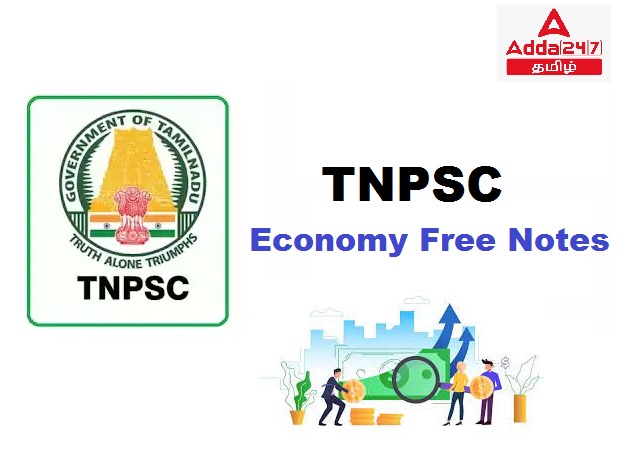இந்தக் கட்டுரையில், TNPSC குரூப் 1, குரூப் 2, குரூப் 2A, குரூப் 4 மாநிலப் போட்டித் தேர்வுகளான TNUSRB, TRB, TET, TNEB போன்றவற்றுக்கான முறைகள் இலவசக் குறிப்புகளைப் பெறுவீர்கள்.தேர்வுக்கு தயாராவோர் இங்குள்ள பாடக்குறிப்புகளை படித்து பயன்பெற வாழ்த்துகிறோம்.
Sectors of Economy
Economic activity
Economic Activities refers to the activity of making, providing, purchasing and selling
goods or services. Economic activities exist at all levels within a society.
Human beings are engaged in various kinds of economic activities. In general, all the
economic activities are broadly categorised into Primary, Secondary and Tertiary
activities.
The Tertiary activities are further subdivided into Quaternary and Quinary activities.
Primary sectors
Activities help man to fulfil his needs and desires, by using resources which are gifted to
man by nature. These activities are directly connected with nature.
Hunting, Gathering, Pastoralism, Fishing, Forestry, Mining and Agriculture are the
primary activities.
Hunting and Gathering
Until 12,000 years ago, all humans lived as hunters and gatherers. At present, only
0.0001% human live as hunters and gatherers.
Gathering and hunting are the oldest known economic activity in the world. It often
involves primitive societies which collect both plants and animals to satisfy their needs
for food, shelter and clothing.
These primitive activities are being carried out still in very few parts of the world.
Gathering is practised in the areas of High altitude zones of Northern Canada, Northern
Eurasia and Southern Chile and in the low altitude zones of the Amazon Basin, Tropical
Africa, Northern fringe of Australia and interior parts of South East Asia.
Present-day gatherers and hunters are confined to a few pockets. Inuit in the Arctic
region, Pygmies of Kalahari, Pintupi, Aborigines of Australians, and Paliyan of South
India are the examples of foragers.
Pastoralism
Pastoralism is the grazing and rearing of different types of animals like cattle, sheep,
goats, etc. in an organised manner to get animals products.
The animals rearing can be primitive, which is carried on by nomads or highly scientific
means on a commercial scale. So, animal grazing and rearing can be divided into two
broad categories as Nomadic Herding and Commercial Livestock Rearing.
Agriculture
Agriculture is the most fundamental form of human activity and includes not only the
cultivation of crops but also the domestication of animals.
Mining
The process of extracting minerals from the earth crust is known as mining.
The discovery of minerals in the history of human development is reflected in many
stages in terms of copper, Bronze and Iron age.
Secondary Activities
Secondary sector transforms the raw materials obtained from the primary sector into
consumer goods. So it consists of manufacturing and industrial activities.
Since it adds value for the raw materials, it is also called a value addition sector.
Industries consume large quantities of energy and require factories and machinery to
convert raw materials into goods and products.
The secondary sector supports both the primary and tertiary sectors.
Tertiary activities
The tertiary industry provides services to its consumers. It is also known as the service
industry/sector.
All types of services and special skills provided in exchange of payments are called
tertiary activities.
Health, education, law, governance and recreation etc., require professional skills. These
services require other theoretical knowledge and practical training.
Most of the tertiary activities are performed by skilled workers and professionally
trained experts and consultants.
Tertiary activities involve commercial output of services rather than the production of
tangible goods.
Expertise provided by service relies more heavily on special skills, experience and
knowledge of the workers rather than on the production techniques, machinery and
factory processes.
Trade and commerce, transport, communication and services are the categories
of the tertiary sector. The tertiary sector is further divided into quaternary and quinary
sector.
Quaternary Activities
The quaternary sector of the economy consists of intellectual activities, example,
libraries, scientific research, education, and information technology.
The workforce who is readily involved in this sector is typically well-educated, and
people are often seen earning well through their participation in this industry.
Quinary Activities
The professions of the people working in this industry are generally referred to as "gold
collar" professions since the services included in the sector focus on the interpretation
of existing or the new ideas, evaluation of new technologies, and the creation of
services.
It involves highly paid professionals, research scientists, and government officials.
The people are designated with high positions and powers, and those who make
important decisions that are especially far-reaching in the world around them often
belong to this category.
**************************************************************************
| Adda247 TamilNadu Home page | Click here |
| Official Website=Adda247 | Click here |




